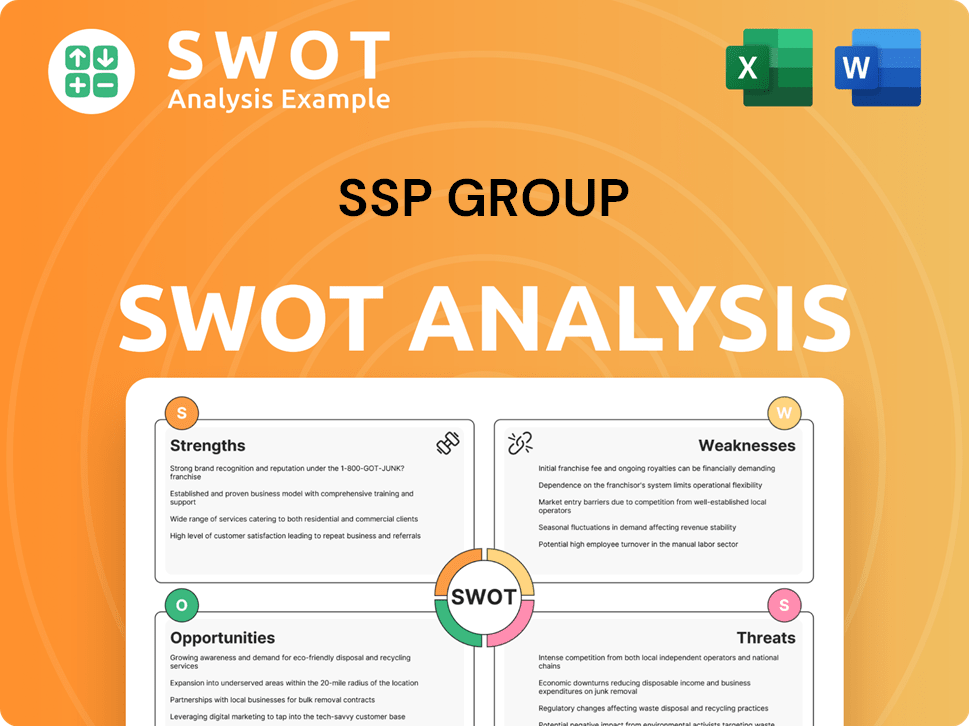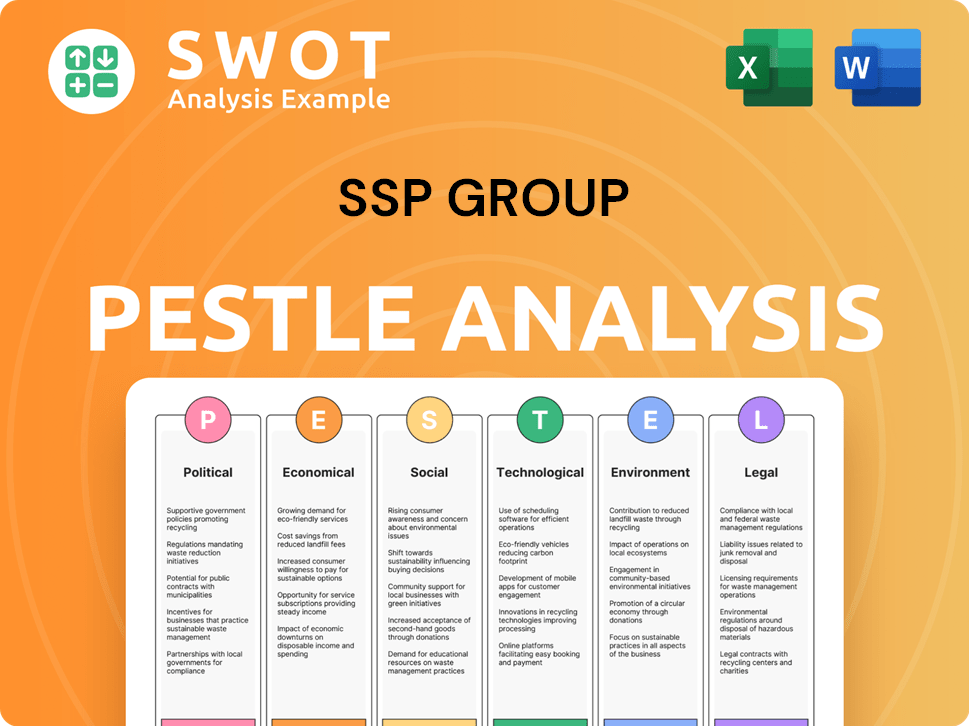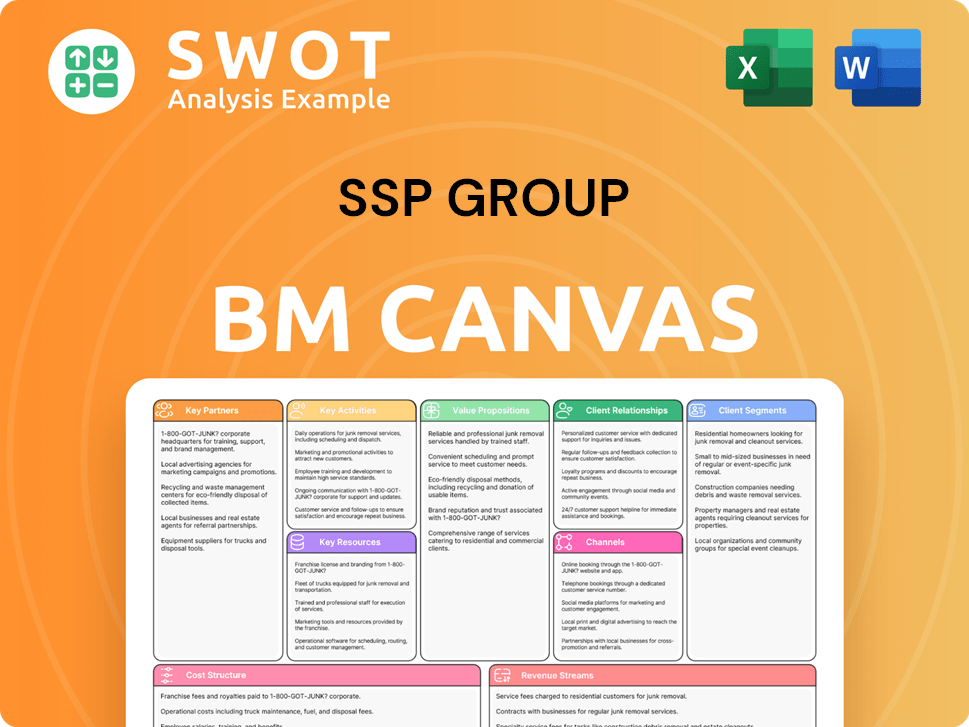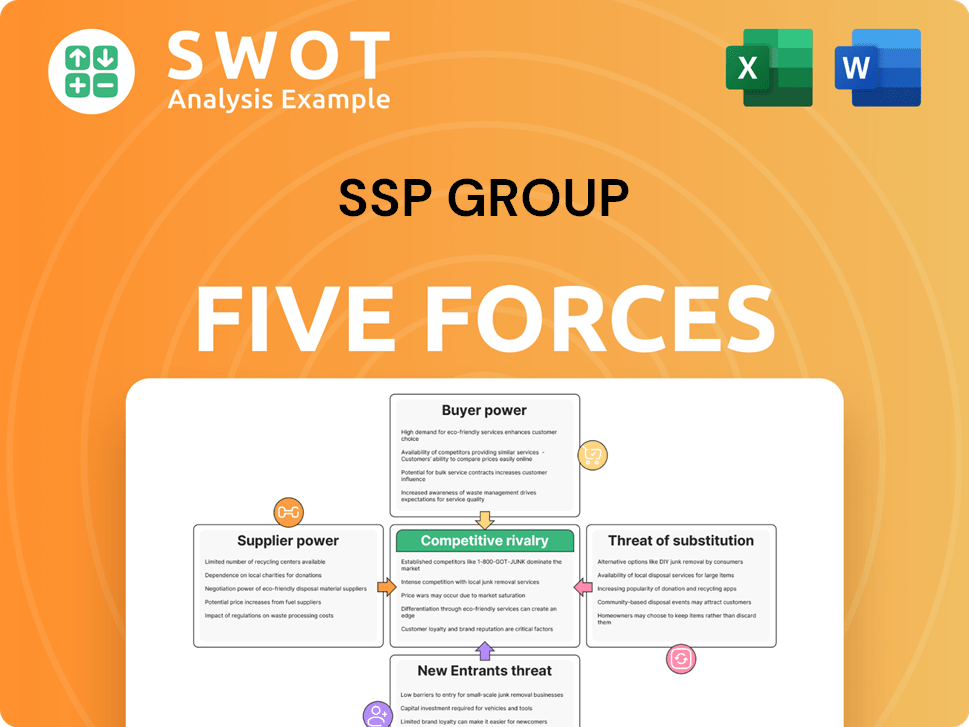SSP Group Bundle
Who Does SSP Group Serve?
In a post-pandemic world of rebounding travel, understanding the "who" behind SSP Group's success is more critical than ever. As a global leader in food and beverage concessions, SSP Group's ability to thrive hinges on a deep understanding of its customer demographics and target market. From airports to train stations, the company's reach spans continents, making its consumer profile incredibly diverse.

This analysis dives deep into the SSP Group SWOT Analysis to uncover the intricacies of its customer base. We'll explore the company's target market segmentation, including customer age range, income levels, and location data, to understand how SSP Group tailors its offerings. This market analysis will reveal how the company defines its target market and adapts to evolving customer preferences and needs, providing valuable insights into the future of travel concessions.
Who Are SSP Group’s Main Customers?
The primary customer segments for SSP Group are individual consumers (B2C) within the travel industry. These customers primarily include people traveling through airports, train stations, and motorway service areas. The company's diverse portfolio of over 550 brands caters to a broad spectrum of travelers, reflecting the global nature of travel and a wide range of preferences and budgets.
SSP Group's target market benefits from 'favorable demographics and demand for travel'. The company strategically focuses on high-growth regions such as North America and Asia Pacific (APAC) & Eastern Europe & Middle East (EEME), which generated 60% of the group's operating profit. Over 70% of its business is in the air travel sector, indicating a strong emphasis on this segment.
SSP Group continuously adapts its target segments through expansion and acquisitions. For example, in 2023, SSP entered the Italian and Icelandic markets and expanded in North America. In 2024, the acquisition of Airport Retail Enterprises Pty Ltd (ARE) in Australia demonstrates ongoing evolution based on market opportunities and growth potential. Understanding the Marketing Strategy of SSP Group provides further insights into their approach.
While specific breakdowns by age, gender, and income level are not publicly detailed, SSP Group's diverse brand portfolio indicates a strategy to cater to a wide range of customers. The company's focus on travel hubs suggests a customer base that includes both domestic and international travelers.
SSP Group segments its target market based on travel locations, including airports, train stations, and motorway service areas. The company's expansion into emerging markets and acquisitions, such as the 2024 acquisition of ARE in Australia, demonstrate a dynamic approach to market segmentation.
SSP Group's offerings are influenced by the increasing prioritization of experiences over material items, particularly among younger people. This trend likely shapes the company's offerings, focusing on providing convenient and appealing dining and retail options for travelers.
SSP Group's strategic reports highlight the importance of favorable demographics and travel demand. The company's focus on high-growth regions and continuous acquisitions, such as the 2023 entry into the Italian and Icelandic markets, reflect its ongoing market research and adaptation strategies.
SSP Group's customer base is diverse, reflecting the global nature of travel. The company's strategic focus on high-growth regions and continuous acquisitions indicates a proactive approach to understanding and serving its target market.
- SSP Group primarily targets travelers in airports, train stations, and motorway service areas.
- The company's brand portfolio caters to a wide range of preferences and budgets.
- SSP Group is expanding in North America and APAC & EEME, which account for 60% of the operating profit.
- The company adapts to changing consumer preferences, such as the increasing focus on experiences.
SSP Group SWOT Analysis
- Complete SWOT Breakdown
- Fully Customizable
- Editable in Excel & Word
- Professional Formatting
- Investor-Ready Format

What Do SSP Group’s Customers Want?
Understanding customer needs and preferences is crucial for the success of any business, and for the SSP Group, this is especially true given its focus on serving customers in travel environments. The company's ability to adapt to the unique demands of travelers, who often experience stress and time constraints, is a key factor in its market success. The focus on customer demographics and the target market allows SSP Group to tailor its offerings to meet the specific needs of its diverse customer base.
SSP Group's approach to understanding its customers is data-driven. The company conducts extensive market analysis and research, such as the Food Travel Insights Survey, to gather information on consumer profiles and preferences. This research helps SSP Group identify trends and adjust its strategies to meet the evolving needs of its target market. This commitment to understanding customer purchasing behavior is essential for maintaining a competitive edge.
The customer base of SSP Group is diverse, encompassing a wide range of travelers with varying needs and preferences. The company's target market segmentation allows it to cater to different demographics, from business travelers seeking convenience to families looking for healthy options. By understanding the customer age range, income levels, and location data, SSP Group can customize its services and offerings to maximize customer satisfaction and loyalty. For a deeper dive into the company's strategic approach, consider reading about the Growth Strategy of SSP Group.
SSP Group's customer preferences are shaped by the unique environment of travel hubs. Efficiency and convenience are paramount, with a growing demand for digital services. Quality and value are also significant, alongside a rising emphasis on health, wellness, and sustainability. SSP Group's commitment to these areas is reflected in its business practices.
- Efficiency and Convenience: Digital ordering options are increasingly popular, with 1 in 5 travelers desiring these services. The EEME/India region shows a particularly high demand at 36%, followed by APAC at 29%.
- Value and Quality: Customers seek high-quality food and beverage options that offer good value for money.
- Health and Wellness: Over two-thirds of global travelers prioritize healthy food and beverage choices, with this preference reaching 80% in EEME/India and 78% in APAC.
- Sustainability: One in five travelers chooses more ethical and sustainable options, reflecting a growing awareness of environmental issues. SSP Group aims for 100% recyclable packaging by 2024 and a 50% reduction in food waste by 2025.
- Customer Satisfaction: SSP Group's customer satisfaction scores improved from 85% in 2022 to 92% in 2023, indicating that the company's efforts to meet customer needs are effective.
SSP Group PESTLE Analysis
- Covers All 6 PESTLE Categories
- No Research Needed – Save Hours of Work
- Built by Experts, Trusted by Consultants
- Instant Download, Ready to Use
- 100% Editable, Fully Customizable

Where does SSP Group operate?
The geographical market presence of the SSP Group is extensive, spanning across 37 countries with approximately 625 locations globally. This wide reach allows the company to cater to a diverse customer base in various travel and leisure settings. The company's operations are strategically divided into key regions to optimize market penetration and operational efficiency.
SSP Group's operations are strategically segmented into four main regions: North America, Continental Europe, the UK & Ireland, and Asia Pacific and Eastern Europe & Middle East (APAC & EEME). This segmentation allows for targeted market analysis and localized strategies. These regions contribute to the company's overall financial performance and growth trajectory.
North America and APAC & EEME are identified as high-growth markets, with SSP actively expanding its presence in these areas. These regions collectively contributed 60% of the group's operating profit in FY24. This expansion strategy includes acquisitions and entering new markets to capitalize on growth opportunities.
In North America, SSP's sales grew by 17% year-on-year in Q1 FY25. This growth was partly driven by acquisitions like Midfield Concessions in Denver and ECG in Canada. The company's strategic focus on expanding its footprint in this region is evident through these acquisitions and organic growth initiatives.
SSP Group is expanding into new markets such as Saudi Arabia and New Zealand. The company secured new business in Sofia, Bulgaria, further diversifying its geographical presence. The company is also focusing on driving like-for-like sales through enhanced customer offers, particularly in rail.
In India, SSP's joint venture, Travel Food Services (TFS), is a market leader in airport food and beverage and lounges. India is SSP's second-largest market by unit numbers. This strong presence in India highlights the company's ability to establish and maintain a leading position in key markets.
The UK & Ireland market was a strong performer in FY24, with an 11% like-for-like sales growth. This demonstrates the effectiveness of SSP's strategies in these established markets. The company continues to focus on driving like-for-like sales through enhanced customer offers, particularly in rail.
Continental Europe's performance was below expectations due to slow recovery, rail strikes, and weak motorway service area trading in Germany. SSP Group is implementing a profit recovery plan for Continental Europe, aiming to increase regional operating profit margin from 1.5% to about 3% in FY25, and around 5% in the medium term. This plan includes disciplined management of the German motorways business ahead of its contracted exit by 2026, with 50% of sites to be exited in H1 FY25. SSP Group's strategy involves localizing its offerings and marketing to succeed in diverse markets.
SSP Group's approach involves localizing its offerings and marketing to succeed in diverse markets. This strategy is crucial for understanding the needs and preferences of the target market. The company's ability to adapt to local tastes and preferences is essential for its success in various regions.
- Focus on high-growth markets like North America and APAC & EEME.
- Implement profit recovery plans for underperforming regions.
- Localize offerings and marketing strategies.
- Enhance customer offers, especially in rail.
For a deeper understanding of SSP Group's financial strategies and business model, you can explore the Revenue Streams & Business Model of SSP Group.
SSP Group Business Model Canvas
- Complete 9-Block Business Model Canvas
- Effortlessly Communicate Your Business Strategy
- Investor-Ready BMC Format
- 100% Editable and Customizable
- Clear and Structured Layout

How Does SSP Group Win & Keep Customers?
SSP Group, a prominent player in the travel food and beverage sector, employs a strategic approach to customer acquisition and retention. Their strategies are designed to attract and keep customers in a competitive market. The company focuses on enhancing the customer experience and developing appealing customer propositions.
A key aspect of SSP Group's strategy involves significant investment in digital solutions. These solutions, including mobile ordering and contactless payments, aim to streamline customer interactions, especially in high-traffic environments. Digital transformation is a critical driver for both acquiring and retaining customers. The company aims to complete 80% of its digital initiatives by 2024.
SSP Group's commitment to understanding its target market is evident in its diverse brand portfolio and tailored marketing efforts. They recognize the different needs and preferences of travelers compared to regular high street customers. This approach is supported by market analysis and consumer profile studies. For example, they offer healthy food options, which are important to over two-thirds of global travelers.
SSP Group focuses on improving the customer experience to drive both acquisition and retention. This involves digital solutions and operational adjustments based on customer feedback. In 2023, the company reported a 14.5% increase in customer satisfaction ratings, showing the effectiveness of their efforts.
Investing in digital solutions like mobile ordering and contactless payments is a key acquisition strategy. SSP Group has invested approximately £5 million in digital solutions. The goal is to complete 80% of these initiatives by 2024, enhancing convenience for customers.
SSP Group emphasizes loyalty programs as a retention strategy. Participation in these programs has grown by 25% year-over-year. These programs help build customer loyalty and provide incentives for repeat business.
SSP Group uses a customer feedback system to gather real-time insights, which leads to operational adjustments. This feedback loop helps improve service and tailor offerings. The 'Customer Experience Improvement Plan' resulted in a 20% increase in repeat customers across European locations.
SSP Group's approach to customer acquisition and retention is multifaceted, focusing on enhancing the customer experience, leveraging a diverse brand portfolio, and implementing targeted marketing strategies. These strategies are critical for success in the competitive travel food and beverage market.
- Enhancing Customer Experience: Improving the customer experience is a primary focus, with investments in digital solutions and operational adjustments based on customer feedback.
- Leveraging Brand Portfolio: Utilizing a diverse portfolio of brands to cater to a wide range of customer preferences and segments.
- Targeted Marketing: Tailoring marketing and product features to specific customer segments, understanding the unique needs of travelers.
- Loyalty Programs: Implementing loyalty programs to encourage repeat business and foster customer loyalty.
- Customer Feedback Systems: Utilizing customer feedback to make real-time operational adjustments and improvements.
SSP Group Porter's Five Forces Analysis
- Covers All 5 Competitive Forces in Detail
- Structured for Consultants, Students, and Founders
- 100% Editable in Microsoft Word & Excel
- Instant Digital Download – Use Immediately
- Compatible with Mac & PC – Fully Unlocked

Related Blogs
- What are Mission Vision & Core Values of SSP Group Company?
- What is Competitive Landscape of SSP Group Company?
- What is Growth Strategy and Future Prospects of SSP Group Company?
- How Does SSP Group Company Work?
- What is Sales and Marketing Strategy of SSP Group Company?
- What is Brief History of SSP Group Company?
- Who Owns SSP Group Company?
Disclaimer
All information, articles, and product details provided on this website are for general informational and educational purposes only. We do not claim any ownership over, nor do we intend to infringe upon, any trademarks, copyrights, logos, brand names, or other intellectual property mentioned or depicted on this site. Such intellectual property remains the property of its respective owners, and any references here are made solely for identification or informational purposes, without implying any affiliation, endorsement, or partnership.
We make no representations or warranties, express or implied, regarding the accuracy, completeness, or suitability of any content or products presented. Nothing on this website should be construed as legal, tax, investment, financial, medical, or other professional advice. In addition, no part of this site—including articles or product references—constitutes a solicitation, recommendation, endorsement, advertisement, or offer to buy or sell any securities, franchises, or other financial instruments, particularly in jurisdictions where such activity would be unlawful.
All content is of a general nature and may not address the specific circumstances of any individual or entity. It is not a substitute for professional advice or services. Any actions you take based on the information provided here are strictly at your own risk. You accept full responsibility for any decisions or outcomes arising from your use of this website and agree to release us from any liability in connection with your use of, or reliance upon, the content or products found herein.